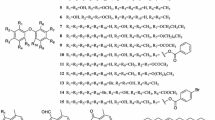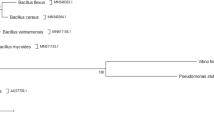Abstract
The spongeLissodendoryx isodictyalis is an odorous, encrusting, blue-gray sponge found on subtidal flats in North Carolina waters. The strong odor ofL. isodictyalis, coupled with the observation that it is rarely overgrown by fouling organisms, suggested that this sponge may produce metabolites with potent antifouling activity. Ethyl acetate extracts ofL. isodictyalis inhibit larval settlement of the barnacleBalanus amphitrite in laboratory assays at 10 ng/ml. Barnacle settlement bioassays of isolated preparative TLC fractions show thatL. isodictyalis produces at least two pungently scented, antifouling agents with EC50 values of less than 85 μg/ml and less than 250 μg/ml, respectively. The most potent agent inhibits settlement at or below a concentration of 400 ng/ml and kills approximately 25 % of settlement-stage barnacle larvae at 400 μg/ml. The other agent causes 100% mortality of larvae at concentrations greater than 400 μg/ml and inhibits settlement at approximately 40 μg/ml. These metabolites ofL. isodictyalis may inhibit overgrowth of the sponge in nature.
Similar content being viewed by others
References
Bakus, G.J., Targett, N.M., andSchulte, B. 1986. Chemical ecology of marine organisms: An overview.J. Chem. Ecol. 12(5):951–987.
Faulkner, D.J. 1977. Some interesting aspects of marine natural products in chemistry.Tetrahedron 33:1421–1443.
Faulkner 1984. Marine natural products: Metabolites of marine invertebrates.Nat. Prod. Rep. 1:551–598.
Fenical, W. 1978. Diterpenoids, pp. 173–245,in P.J. Scheuer (ed.). Marine Natural Products, Vol. II. Academic Press, New York.
Fenical, W. 1982. Natural products chemistry in the marine environment.Science 215:923–928.
Gerhart, D.J., Rittschof, D., andMayo, S.W. 1988. Chemical ecology and the search for marine antifoulants: Studies of a predator-prey symbiosis.J. Chem. Ecol. 14(10): 1903–1915.
Goad, L.J. 1978. The sterols of marine invertebrates: Composition, biosynthesis, and metabolism, pp. 75–172,in P.J. Scheuer (ed.). Marine Natural Products, Vol. II. Academic Press, New York.
Keifer, P.A., Rinehart, K.L., andHooper, I.R. 1986. Renillafoulins, antifouling diterpenes from the sea pansyRenilla reniformis (Octocorallia).J. Org. Chem. 51:4450–4454.
Laubenfels, M.W.de 1947. Ecology of the sponges of a brackish water environment at Beaufort, N.C.Ecol. Monogr. 17(l):31–46.
Rittschof, D., Branscomb, E.S., andCostlow, J.D. 1984. Settlement and behavior in relation to flow and surface in larval barnacles,Balanus amphitirte Darwin.J. Exp. Mar. Biol. Ecol. 82:131–146.
Rittschof, D., Hooper, I.R., Branscomb, E.S., andCostlow, J.D. 1985. Inhibition of barnacle settlement and behavior by natural products from whip corals,Leptogorgia virgulata (Lamarck, 1815).J. Chem. Ecol. 11:551–563.
Rittschof, D., Hooper, I.R., andCostlow, J.D. 1986. Barnacle settlement inhibitors from sea pansies,Renilla reniformis.Bull. Mar. Sci. 39(2): 376–382.
Sokal, R.R., andRohlf, R.J. (eds.). 1981. Biometry. Freeman and Co., San Francisco.
Standing, J., Hooper, I.R., andCostlow, J.D. 1982. Inhibition and induction of barnacle settlement by natural products present in octocorals.J. Chem. Ecol. 10:823–834.
Stoecker, D. 1978. Resistance of a tunicate to fouling.Biol. Bull. 155:615–626.
Sutherland, J.P. 1984. The structure and stability of marine macrofouling communities, pp. 202–206,in J.D. Costlow and R.C. Tipper (eds.). Marine Biodeterioration: An Interdisciplinary Study. Naval Institute Press, Annapolis.
Sutherland, J.P., andKarlson, R.H. 1977. Development and stability of the fouling community at Beaufort, North Carolina.Ecol. Monogr. 47:425–446.
Targett, N.M., Bishop, S.S., McConnell, D.J., andYoder, J.A. 1983. Antifouling agents against the benthic marine diatomNavicula salinicola: Homarine from the gorgonianLeptogorgia virgulata andL. setacea and analogs.J. Chem. Ecol. 9:817–829.
Tursch, B., Braekman, J.C., Daloze, D., andKaisin, M. 1978. Terpenoids from coelenterates, pp. 247–296,in P.J. Scheuer (ed.). Marine Natural Products, Vol. II. Academic Press, New York.
Ware, G.N. 1984. The patterns and mechanisms of antifouling in some temperate sponges. PhD dissertation. Duke University, Durham, North Carolina.
Wiedenmayer, F. 1977. Shallow-water sponges of the western Bahamas. Birkhauser Verlag, Basel. 287 pp.
Author information
Authors and Affiliations
Rights and permissions
About this article
Cite this article
Sears, M.A., Gerhart, D.J. & Rittschof, D. Antifouling agents from marine spongeLissodendoryx isodictyalis carter. J Chem Ecol 16, 791–799 (1990). https://doi.org/10.1007/BF01016489
Received:
Accepted:
Issue Date:
DOI: https://doi.org/10.1007/BF01016489




